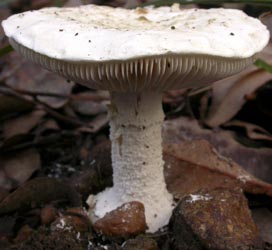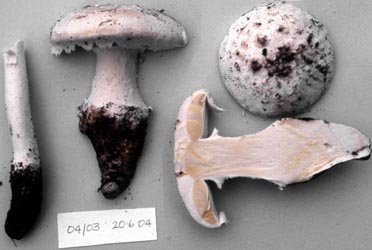|
[ Section Lepidella page. ]
[ Amanita Studies home. ]
[ Keys & Checklist/Picturebooks ] Amanita ananaeceps (Berk.) Sacc. 

Technical description (t.b.d.) BRIEF DESCRIPTION: The following is based on the description of Bas (1969). The cap of Amanita ananaeceps is about 60 - 100 mm wide, probably convex to plano-convex, with a nonsulcate, appendiculate margin. The original color was reported by Bas unknown, but possibly whitish. The cap is covered with small, conical to shapeless warts. The original description states the warts are placed on areolae. Bas' opinion was that this was occasional occurrence due to weather conditions. His view was supported by the fact that only one specimen in the type collection appears to have been areolate. The gills are probably crowded and moderately broad. The stem is about 70 - 110 x 10 - 14 mm, equal or slightly tapering upward, and exannulate; remnants of volva are lacking or forming a slight, subfloccose rim at the top of the stipe's bulb, which is short marginate to submarginate, and napiform to ellipsoid. The stipe is exannulate or bears a submembranous-felted, subapical annulus. The spores measure (9-) 9.5 - 11.5 x (6.5-) 7 - 8 (-8.5) Ám and are amyloid and broadly ellipsoid. Clamps are present at bases of basidia. The species was originally described from Tasmania. Bas placed this species in this stirps Grossa (see A. grossa (Berk.) Sacc.). Bas thought the present species might be a synonym of A. farinacea (Cooke & Massee) Cleland & Cheel. -- R. E. Tulloss Photo: Katrina Symes (top, Western Australia, Australia).
[ Section Lepidella page. ]
[ Amanita Studies home. ]
[ Keys & Checklist/Picturebooks ] Last changed 6 October 2009. |